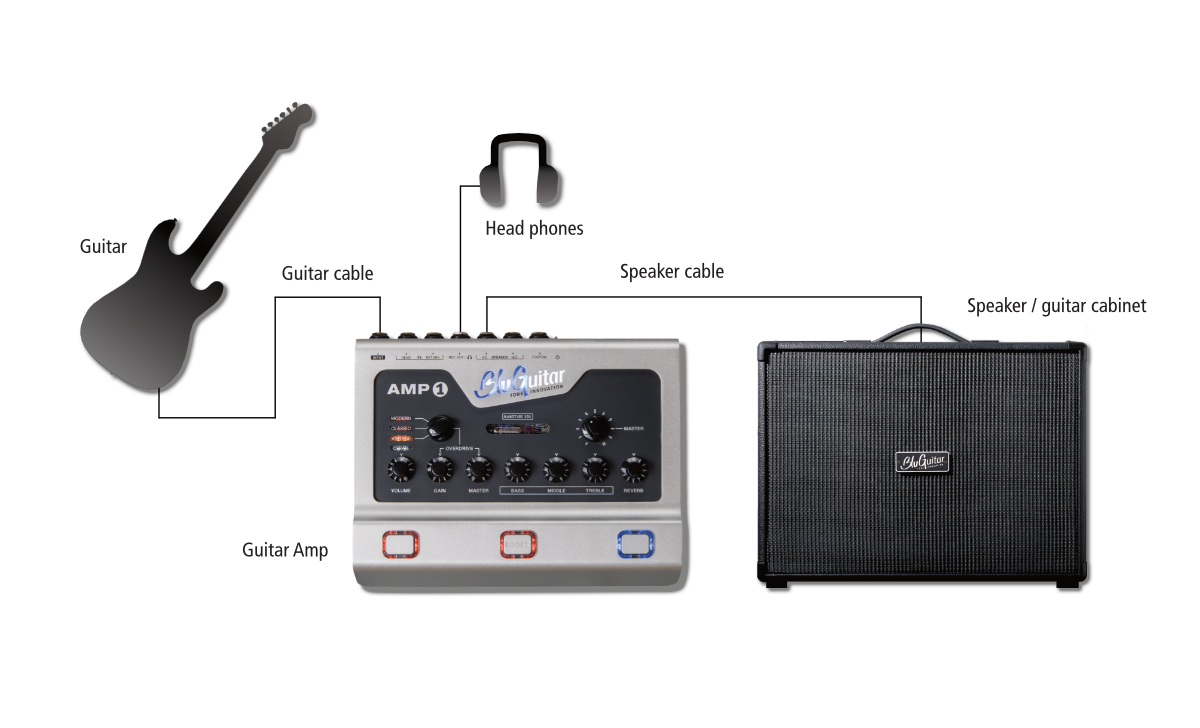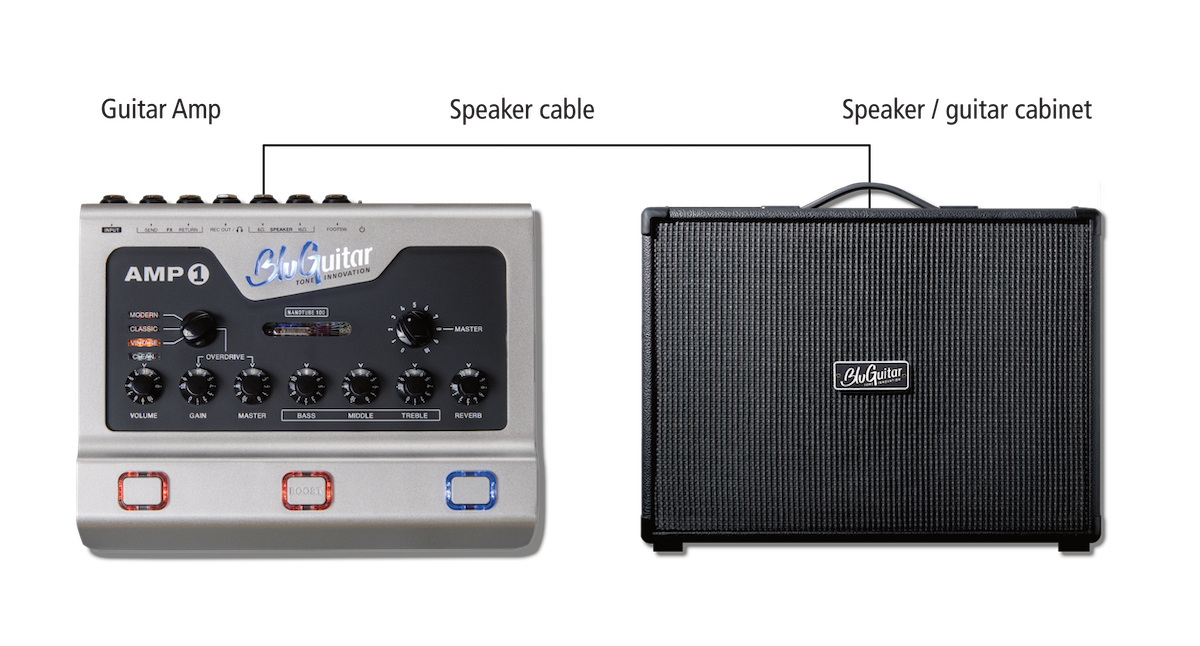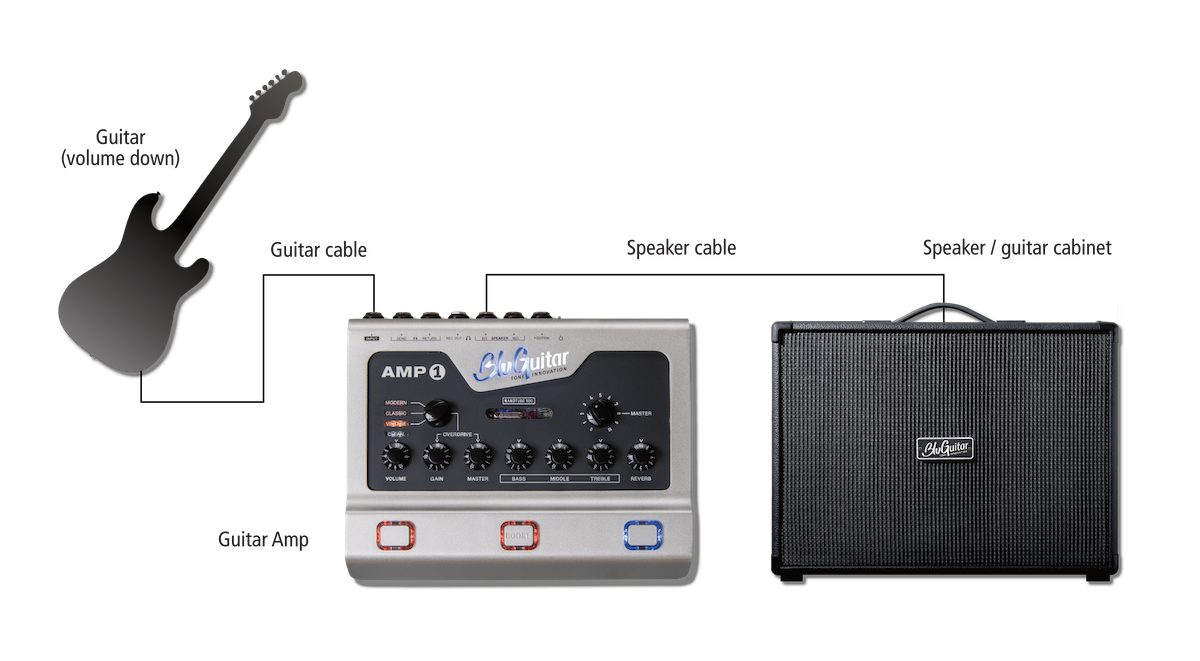How to troubleshoot - the best strategy
In this article, we're sharing with you what we believe is the best strategy to troubleshoot problems with your guitar rig - no matter if you own a BluGuitar product or products of other manufacturers. It's based years of experience with all kinds of gear and issues. If you follow these instructions, you will be able to exactly determine the fault, which will help you with solving the issue and/or acquiring service. Since the center of every guitar rig is the amp, we'll take it from there and then work our way through the peripheral devices.
First things first: minimize the signal chain
The more devices and components there are in the signal chain, the greater the probability that one of them will cause problems - and the more difficult it will be to locate the source of the fault. Therefore, when troubleshooting, you should start with the absolute minimum of components and remove everything else from the signaling for the time being:
Guitar -> guitar cable -> amp -> speaker cable -> speaker / headphones

Double check for "stupid" mistakes
Before we start locating the defect, let's make sure there really is a defect. Please double check your rig for the following things:
- Are all units in the signal chain switched on?
- Are all cables plugged in correctly?
- Is the volume knob on your guitar turned up?
- Are all volume controls on your amp (and pedals and other devices, if used) turned up?
- In case of the AMP1: are the tone controls (BASS, MIDDLE, TREBLE) turned up?
- Are all cables in the correct sockets?
Categorize the problem
In order to locate a possible defect in your guitar rig, it is essential to first detect what kind of issue we're dealing with. Depending on which issue you're experiencing, the troubleshooting process will look slightly different. So the question now is: which of the following categories des your problem fit into?
No function (unit doesn't switch on)
If your unit doesn't switch on at all, please check the power supply:
- Use a different power outlet
- Check the mains lead
- Check the fuse of the device
If the power supply is fine and the unit still doesn't switch on, it is most likely defective.
DeleteNo sound
Make sure everything's properly connected and all controls are turned somewhat up. Now switch off the NoiseGate (if present). You should at least hear some noise in the speaker. If not, the amp is most likely defective.
You can locate the defect more precisely by plugging the guitar straight into the amp's FX RETURN (or LINE IN):
- If you still get no sound, then the power amp is defective. For double checking you might want to use the FX SEND into another amp. If this works, you have the confirmation that the power amp is the problem.
- If, on the other hand, there is a sound audible when plugging your guitar straight into the power amp, then the preamp is defective. Again, can you double check this by connecting the FX SEND to another amp. If you still get no sound, you have the confirmation that the preamp is the problem.
In case your amp has different preamp channels (like the AMP1), please switch between the channels. If you get no sound from all of them, then the defect is in the shared input stage in front of the separate channels - or after them. If only one of the channels is the cause of the problem, then only this particular channel will not work, while the others will work just fine.
If your stripped down rig works fine, all peripheral devices (if present) should be brought back into the signal chain gradually to identify the source of the problem.
DeleteUnwanted noise (hum, hiss, feedback, bad sound)
Noise such as humming, beeping, feedback, etc., can have many causes when it comes to guitar amplifiers. The source of the noise can be identified in the following ways:
- First remove all effects (pre-switch effects and loop-in effects) from the signal path, pull the guitar cable out from the input of the AMP1, connect the loudspeakers and switch on the noise gate. It should be quiet now.

- So if it stays quiet here, we go directly to the next check step. If there is already noise or problems at this point, they are most likely related to the speaker cable or the speaker. A good way to check this is to compare the signal at the SPEAKER OUTs with the REC OUT signal. If the REC OUT signal is clean, but the SPEAKER OUT signal is not, the AMP1 is not the cause of the noise (as you can read here, the REC OUT is located behind the SPEAKER OUTs - noise that is only audible at the SPEAKER OUTs must therefore have something to do with the peripheral equipment connected to the SPEAKER OUTs).
- Turn off the noise gate. What you hear now are the noises of the preamp. That the overdrive channels hiss is completely normal and is in the nature of things. The more gain, the higher the noise level.
If you are facing a crackling, sizzling noise, however, this can be caused by neon lights or by a running washing machine, vacuum cleaner or hairdryer in the same building. The remedy in this case can be a change of the power outlet, provided that it is connected to a different circuit.
- Next, connect a guitar to the amp's input with a guitar cable and turn the guitar's volume all the way down. If now hum occurs, it's coming from the cable - or the wiring in the guitar is wrong.

- Then turn up the volume of the guitar and you can hear the noises that the guitar (pickups, etc.) are making. Above all, feedback often occurs between the guitar pickups and the loudspeaker. Microphonic pickups can be the cause of this. If this is the case, the feedback will be less if you increase the distance between the pickups and the speaker, i.e. if you move the guitar away from the speaker cab. Likewise, the feedback should decrease when you turn down the treble pot on the guitar or reduce the volume of the amp.
- If the noise thus far has not occurred, all effect devices should be brought back into the signal chain gradually to identify the source of the noise.
- The last point to consider is a missing or poor electrical grounding as the cause of the noise. The AMP1, like any other guitar amp, must always be properly grounded. Missing grounding is dangerous! Please make sure that the correct power cable is used. Sometimes using a different outlet or circuit will help.
Good to know - special cases
In addition to the general cases listed above, there are also a few special cases that also fall into the category of "interfering noises".
On the one hand, the combination of certain products can lead to problems without one of the individual components having an actual fault. A striking example of this would be the use of a drive pedal in front of a hi-gain amp: You can easily get too much gain altogether, which leads to uncontrollable feedback.
On the following very specific special cases, we have further information for you:
Malfunction (switches, knobs, controls)
Wiggle the cables, flick the switches and turn the knobs to detect bad connections or corrosion. Insert the jack plug of your cable into the socket concerned and pull it out again several times. This will allow you to clean up the corrosion and get the bushings working properly again.
If this doesn't help, it is likely that your amp needs service.
DeleteProduct defective?
If the result of your troubleshooting is that your device is defective, it usually is best to acquire service. In case of a defective BluGuitar product, you can find tips on how to proceed here: I have a defective BluGuitar product - what now?